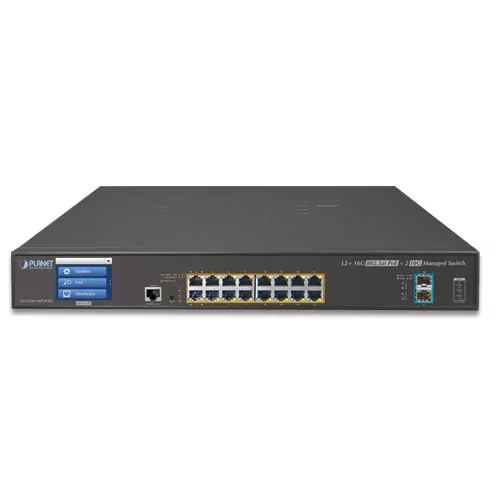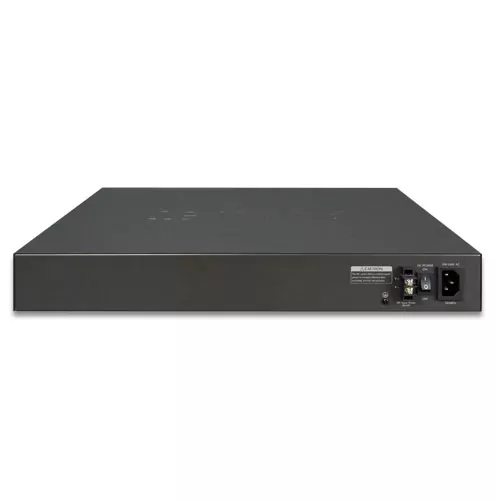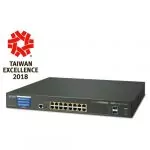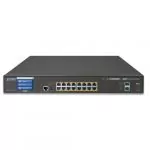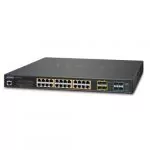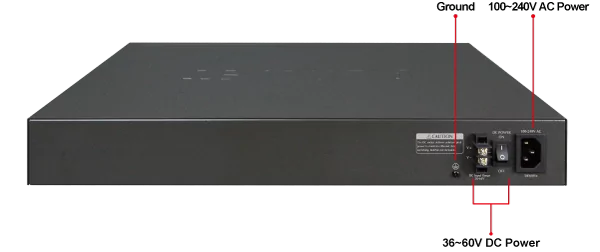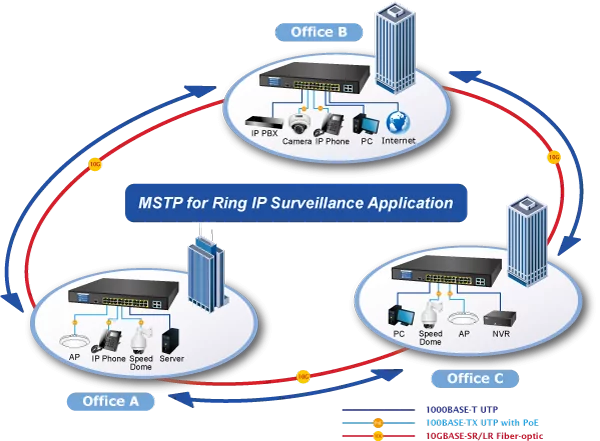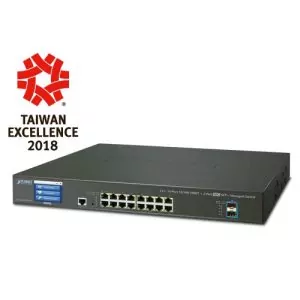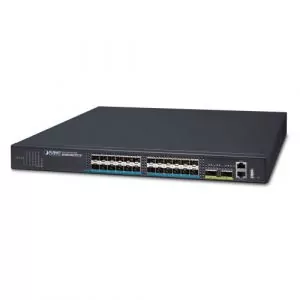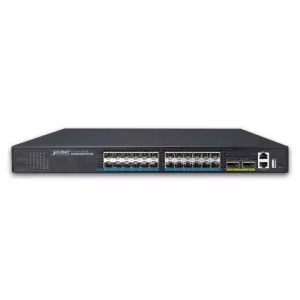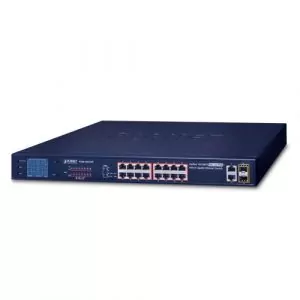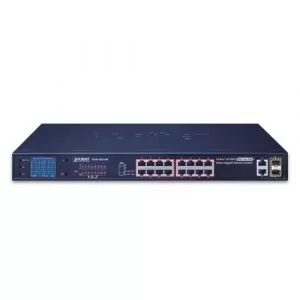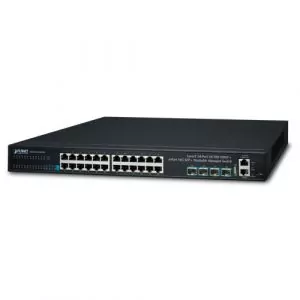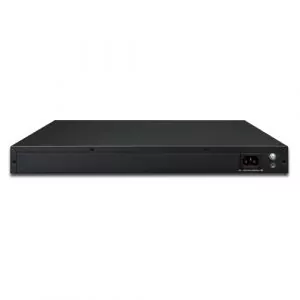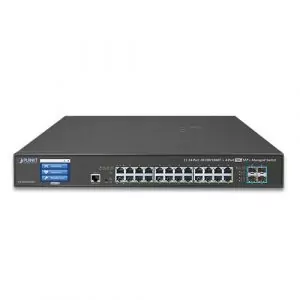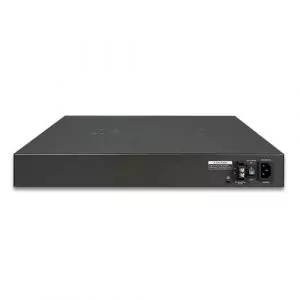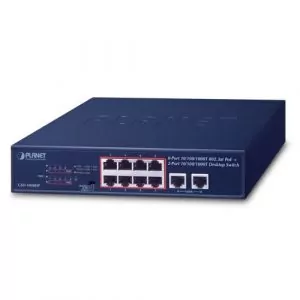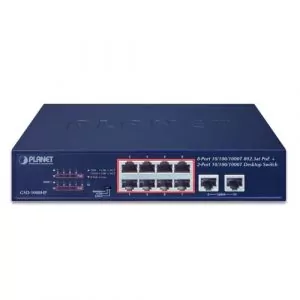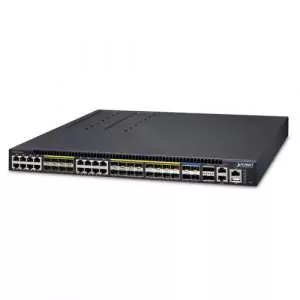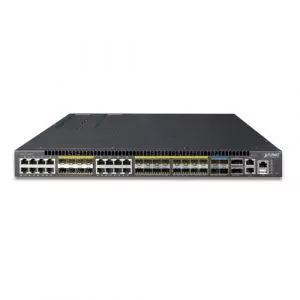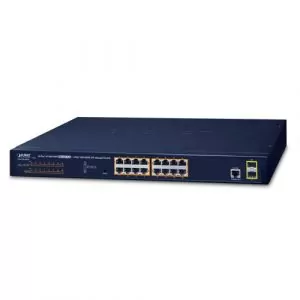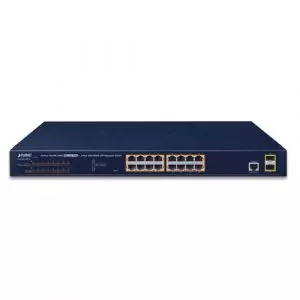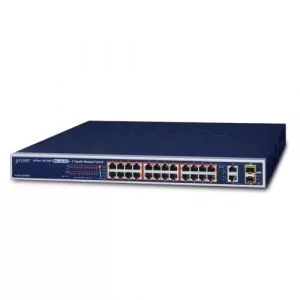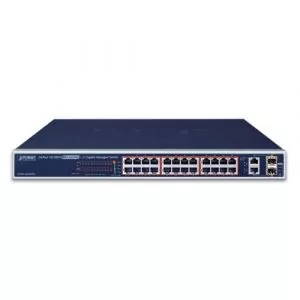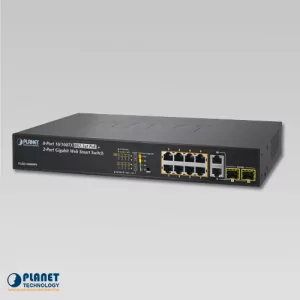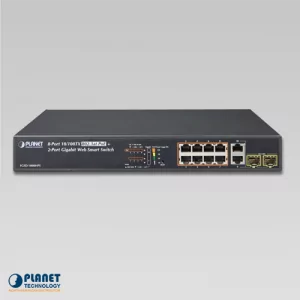GS-5220-16P2XVR
L3 , 16-Port 10/100/1000T 802.3at PoE + 2-Port 10G SFP+ Managed Switch with Color LCD Touch Screen, ERPS Ring, Cybersecurity featuresHardware L3 OSPFv2, IPv4/IPv6 Static Routing,W/48V Redundant Power Optional, 220W PoE Budget,ONVIF
- Applicazioni
- SPECIFICHE
- DOWNLOAD
Descrizione
Applicazione Layer 2+ VLAN Static Routing e PoE
Conforme allo standard IEEE 802.3at PoE+, questa serie di switch offre fino a 36 watt di potenza in uscita per porta e un budget PoE fino a 220 watt, in grado di distribuire fino a 16 dispositivi alimentati PoE; integra robusti protocolli di instradamento del traffico Layer 3 IPv4 / IPv6, garantendo un routing affidabile tra VLAN e segmenti di rete. I protocolli di routing possono essere applicati mediante interfaccia VLAN con fino a 32 voci di routing.
Protocollo Multiple Spanning Tree con soluzione Office IP PoE per PMI e Gruppi di lavoro
Questi switch dispongono di una forte e rapida capacità di auto-recupero, allo scopo di evitare interruzioni del servizio e intrusioni esterne; Incorporano, nella rete di automazione del cliente, la tecnologia 802.1s MSTP (Multiple Spanning Tree Protocol), per potenziare l’affidabilità del sistema e il tempo di attività.
Conformi allo standard PoE IEEE 802.3af/IEEE 802.3at, possono connettersi direttamente con qualsiasi nodo finale abilitato IEEE 802.3at PoE, quali telecamere di rete PTZ e telecamere speed dome. Con questi modelli di switch, le aziende, con l‘infrastruttura di rete disponibile, possono realizzare facilmente un sistema wireless di AP, telecamera IP e VoIP in cui l’alimentazione può essere controllata a livello centrale.
| Hardware Specifications | |
|---|---|
| Copper Ports | 16 10/100/1000BASE-T RJ45 auto-MDI/MDI-X ports |
| SFP+ Slots | 2 10GBASE-SR/LR SFP+ interfaces (Port-17 to Port-18) Compatible with 1000BASE-SX/LX/BX SFP transceiver |
| Console | 1 x RS232-to-RJ45 serial port (115200, 8, N, 1) |
| Switch Architecture | Store-and-Forward |
| Switch Fabric | 72Gbps/non-blocking |
| Throughput | 53.57Mpps@64Bytes |
| Address Table | 16K entries, automatic source address learning and aging |
| Shared Data Buffer | 32M bits |
| Flow Control | IEEE 802.3x pause frame for full-duplex Back pressure for half-duplex |
| Jumbo Frame | 10K bytes |
| Reset Button | < 5 sec: System reboot > 5 sec: Factory default |
| Dimensions (W x D x H) | 440 x 300 x 56 mm, 1.25U height |
| Weight | GS-5220-16P2XV:4273g
GS-5220-16P2XVR:4373g |
| LED |
System: SYS (Green) AC/PWR (Green) DC (Green) (GS-5220-16P2XVR Only) Fan1/2/3 Alert ( Red ) PoE PWR Alert ( Red ) PoE Ethernet Interfaces (Port-1 to Port-16): PoE In-use (Orange) Ethernet Interfaces (Port-1 to Port-16): 1000 LNK/ACT (Green), 10/100 LNK/ACT (Orange) 1/10G SFP+ Interfaces (Port-17 to Port-18): 1G (Green), 10G (Orange) |
| Power Consumption | GS-5220-16P2XV: Max. 271 watts/924.69 BTUGS-5220-16P2XVR: AC: Max. 271 watts/924.69 BTU DC: Max. 36.6 watts/124.88 BTU |
| Power Requirements – AC | GS-5220-16P2XV: AC 100~240V, 50/60Hz, 2.6AGS-5220-16P2XVR: AC 100~240V, 50/60Hz, 2.6A |
| Power Requirements – DC | GS-5220-16P2XVR: DC 36~60V, 2A |
| ESD Protection | 6KV DC |
| Fan | 3 smart fans |
| Power over Ethernet | |
| PoE Standard | IEEE 802.3af/802.3at PoE PSE |
| PoE Power Supply Type | End-span |
| PoE Power Output | Per port 53V DC, 36 watts (max.) |
| Power Pin Assignment | End-span: 1/2(-), 3/6(+) |
| PoE Power Budget | 220 watts (max.) |
| PoE Ability PD @ 7 watts | 16 units |
| PoE Ability PD @ 15 watts | 14 units |
| PoE Ability PD @ 30 watts | 7 units |
| Layer 2 Management Functions | |
| Port Configuration | Port disable/enable Auto-negotiation 10/100/1000Mbps full and half duplex mode selection Flow control disable/enable |
| Port Status | Display each port’s speed duplex mode, link status, flow control status, auto-negotiation status, trunk status |
| Port Mirroring | TX/RX/Both Many-to-1 monitor |
| VLAN | 802.1Q tagged-based VLAN Q-in-Q tunneling Private VLAN Edge (PVE) MAC-based VLAN Protocol-based VLAN Voice VLAN MVR (Multicast VLAN registration) Up to 255 VLAN groups, out of 4095 VLAN IDs |
| Link Aggregation | IEEE 802.3ad LACP/static trunk 9 groups with 2 port per trunk |
| Spanning Tree Protocol | IEEE 802.1D Spanning Tree Protocol (STP) IEEE 802.1w Rapid Spanning Tree Protocol (RSTP) IEEE 802.1s Multiple Spanning Tree Protocol (MSTP) |
| QoS | Traffic classification based, strict priority and WRR 8-level priority for switching: – Port number – 802.1p priority – 802.1Q VLAN tag – DSCP/ToS field in IP packet |
| IGMP Snooping | IGMP (v1/v2/v3) snooping, up to 255 multicast groups IGMP querier mode support |
| MLD Snooping | MLD (v1/v2) snooping, up to 255 multicast groups MLD querier mode support |
| Access Control List | IP-based ACL/MAC-based ACL Up to 256 entries |
| Bandwidth Control | Per port bandwidth control Ingress: 100Kbps~1000Mbps Egress: 100Kbps~1000Mbps |
| Layer 3 Functions | |
| IP Interfaces | Max. 8 VLAN interfaces |
| Routing Table | Max. 32 routing entries |
| Routing Protocols | IPv4 software static routing IPv6 software static routing |
| Management | |
| Basic Management Interfaces | Console; Telnet; Web browser; SNMP v1, v2c; 2.4-inch color LCD touch screen |
| Secure Management Interfaces | SSH, SSL, SNMP v3 |
| SNMP MIBs | RFC 1213 MIB-II RFC 1493 Bridge MIB RFC 1643 Ethernet MIB RFC 2863 Interface MIB RFC 2665 Ether-Like MIB RFC 2819 RMON MIB (Groups 1, 2, 3 and 9) RFC 2737 Entity MIB RFC 2618 RADIUS Client MIB RFC 2863 IF-MIB RFC 2933 IGMP-STD-MIB RFC 3411 SNMP-Frameworks-MIB RFC 4292 IP Forward MIB RFC 4293 IP MIB RFC 4836 MAU-MIB IEEE 802.1X PAE LLDP |
| Standards Conformance | |
| Regulatory Compliance | FCC Part 15 Class A, CE |
| Standards Compliance | IEEE 802.3 10BASE-T IEEE 802.3u 100BASE-TX/100BASE-FX IEEE 802.3z Gigabit SX/LX IEEE 802.3ab Gigabit 1000T IEEE 802.3ae 10Gb/s Ethernet IEEE 802.3x flow control and back pressure IEEE 802.3ad port trunk with LACP IEEE 802.1D Spanning Tree Protocol IEEE 802.1w Rapid Spanning Tree Protocol IEEE 802.1s Multiple Spanning Tree Protocol IEEE 802.1p Class of Service IEEE 802.1Q VLAN tagging IEEE 802.1x Port Authentication Network Control IEEE 802.1ab LLDP IEEE 802.3af Power over Ethernet IEEE 802.3at Power over Ethernet Plus RFC 768 UDP RFC 793 TFTP RFC 791 IP RFC 792 ICMP RFC 2068 HTTP RFC 1112 IGMP v1 RFC 2236 IGMP v2 RFC 3376 IGMP v3 RFC 2710 MLD v1 FRC 3810 MLD v2 |
| Environment | |
| Operating | Temperature: 0 ~ 50 degrees C Relative Humidity: 5 ~ 95% (non-condensing) |
| Storage | Temperature: -10 ~ 70 degrees C Relative Humidity: 5 ~ 95% (non-condensing) |


